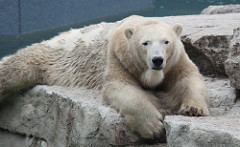 So I’m sure you’ve been following all of this Ark Park business going on down in Kentucky. Yes, it is ridiculous, and yes, I have to admit that I was trying desperately to ignore it. As a climate change person here at NCSE, I felt sure I could leave this Ark nonsense to the evolution team.
So I’m sure you’ve been following all of this Ark Park business going on down in Kentucky. Yes, it is ridiculous, and yes, I have to admit that I was trying desperately to ignore it. As a climate change person here at NCSE, I felt sure I could leave this Ark nonsense to the evolution team.
But, alas, it turns out there is plenty of nonsense on the Ark to go around. Surprisingly (or not?), there’s some terrible climate change denial going on at the Ark Park. As I was looking through some pictures of the attraction, I stopped at one in particular. It was a photograph of a sign that asked the question:
How did Noah keep [polar bears] cool on the Ark?
The answer was:
Polar bears do not need to live in a cold climate. Their special adaptations are well suited for an icy climate, but many warm-weather zoos house polar bears. So even if polar bears were on the Ark, there would not have been a need to keep them cool.
Wait, what? Polar bears don’t care about the local temperature? With that reasoning there could be polar bears right now sunning themselves on South Beach.
This is so ridiculous as to be easy to dismiss, but I have to say that the larger question of how warm-weather zoos are able to maintain polar bears did get me wondering. How is it that we can have polar bears at zoos in warm places like San Diego, but the bears don’t wander down from the Arctic to catch some rays on their own? Is the zoo putting all the bears in an ice chamber whenever they’re off exhibit? Are these so called “polar bears” really dogs in elaborate costumes? Or are polar bears not as attuned to temperature as I was led to believe?
It turns out the science behind polar bear care is really (ahem) cool. It isn’t that polar bears don’t need cold weather; it’s that there is a lot of (gasp!) technology and (double gasp!) biology that goes into helping them survive in warmer zoos.
The San Diego Zoo’s blog has a good summary here:
Our 130,000-gallon pool is chilled to under 55 degrees Fahrenheit. The shallow area allows the bears to lie down and even sleep if they choose. The mid-range allows for great soaking opportunities, and the 12-foot deep end allows for complete submersion and swimming. On most summer days, the breeze through the exhibit comes right off of San Diego Bay, so it is a cooling sea breeze. Throughout the exhibit there are numerous shaded areas with various bedding materials for the bears to sleep on. There is also a portable air conditioner we can direct up by the back area where they especially like to sleep. Inside the bedroom area, we also have air conditioning to take the heat out if absolutely necessary.
So basically, the polar bears have a cool pool, lots of shade, and a couple air conditioners going. I’m sure that for some of you dealing with the August heat, that sounds amazing! But it is probably a little too high-tech for the Ark. Maybe Noah had some amazing palm fronds waving twenty-four/seven?
But that’s not all they do at the San Diego zoo to keep those bears cool. The author goes on:
The real reason we can keep our polar bears comfortable, even on the hottest days, is by limiting the amount of fat they have on their body…Here in San Diego, our nutrition staff has developed a diet that is 5- to 10-percent fat, so our polar bears get what they need for good health but not for bulking up for a cold winter. All of our bears would weigh much more than they do now if they had those fat layers.
Wait, polar bears on diets? That’s right—the zoo has it figured out. Which diet do you think they used on the Ark? The grapefruit diet? Atkins? Maybe they went paleo…
So it turns out that not only can you keep polar bears cool in zoos, but you have to. And, man, do you have to work at it. Is this something that anyone could manage on a Bronze or Iron Age boat? Well, it’s fun to pretend—but without a modern understanding of polar bear biology and the technology to support it, those poor bears would have been as doomed as the unicorns.
Did I forget to mention, unicorns were on board at the Ark Park, too? Oof!
Image from: PeterR75

